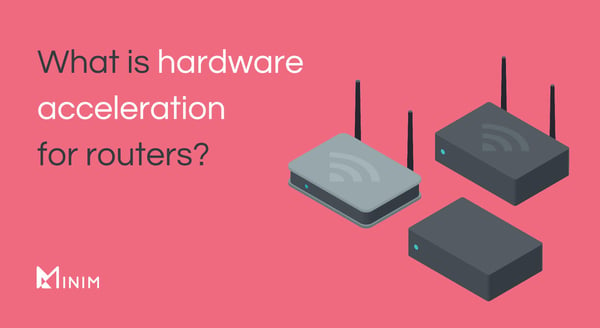
What is hardware acceleration for routers?
When it comes to configuring routers, it can be tricky to know what options to enable or disable in order to deliver the perfect internet experience. One of the most commonly known options is hardware acceleration, a term that some users may find familiar.
In computers, hardware acceleration is shown as an option that can be enabled or disabled to change how the PC is performing. But what exactly is hardware acceleration for routers, and how can it impact an at-home internet experience?

What is hardware acceleration?
In terms of computing, enabling hardware acceleration allows a computer’s CPU to offload certain tasks to other specialized hardware and to perform more efficiently overall, putting less strain on the CPU.
Although hardware acceleration can be defined loosely as offloading any action from the CPU to another piece of hardware, it’s typically sound cards and GPUs that are affected the most. In the case of hardware acceleration on a sound card, an application running on a computer such as Spotify could utilize hardware acceleration in a specialized sound card to play high-quality audio without causing added strain on the CPU. Allowing the hardware that’s specialized for certain jobs like sound cards is ideal, but sometimes it can cause apps to run in an unstable way, which isn’t ideal.
What is hardware acceleration for routers?
Hardware acceleration for routers is slightly different than hardware acceleration for computers, although the concept is similar.
Ultimately, a router's job is to inspect traffic coming in on each of its ports, look up the destination port, and send the traffic to its correct destination. When making these routing decisions, other steps come into play, such as allowing or discarding the traffic—this is your firewall in action—or commonly performing Network Address Translation (NAT), which rewrites the traffic's address from your local private address to a public one given to your router.
When a router needs to make a decision about a packet (a piece of traffic), it needs to send it to its CPU, which is a limited resource. Normally, the router has to make this decision on each packet that passes through the router. When making these decisions, the router needs to look only at the first few bytes of each packet, but this adds up quickly.
One of the important performance metrics that a large number of routers omit is the number of packets per second (PPS) they can process, which is frequently the limiting factor on the ultimate possible performance to get out of a router.
Hardware acceleration is a way to reduce the number of packets for which a router has to make a decision. With it turned on, the CPU only looks at the first few packets of a stream of traffic to make its decisions. If the traffic is allowed, the router will pick the destination and tell a specialized chip to make the same decision on all of the packets that are part of the same stream.
Usually, hardware acceleration can be enabled or disabled through the LAN settings in a router’s admin panel.
Interested in learning more about internet speeds? See this breakdown of what good download and upload speeds for home internet look like.
Should hardware acceleration be enabled on my router?
Many routers utilize hardware acceleration to perform efficiently, but it isn't typically critical to their operation.
The pros of enabling hardware acceleration on your router are that it allows for higher throughput speeds and reduces latency and CPU utilization on the router. Hardware acceleration may also be necessary for achieving higher WAN throughput as well.
The cons to enabling hardware acceleration is that it might not allow for port forwarding (such as hosting gaming servers), parental controls, STP for bridged Ethernet LANs, or Point-to-Point Protocol over Ethernet (PPPoE). Enabling hardware acceleration on a router may also cause some streaming devices like Apple TV or Chromecast to become unstable.
One thing to note is automatic hardware acceleration modes as an option on compatible routers. Routers with an automatic hardware acceleration option can turn on the option when conditions are met that allow for hardware acceleration to reduce CPU utilization under heavy loads.
What happens if I disable hardware acceleration on my router?
It’s possible to disable hardware acceleration on your router at home. However, unless your router is a top-of-the-line model that can handle heavy loads, you'll notice a drop in your speeds if you choose to do so.
One user on a forum saw their download speeds drop from 900 Mbps to 200 Mbps after disabling hardware acceleration on their router. This is common, and disabling hardware acceleration will most likely result in a drop in speeds and performance due to overworking the router's CPU. In general, it's recommended to keep hardware acceleration enabled so that the specialized hardware components in your router can do their jobs so that the CPU can perform optimally unless you're having compatibility issues.